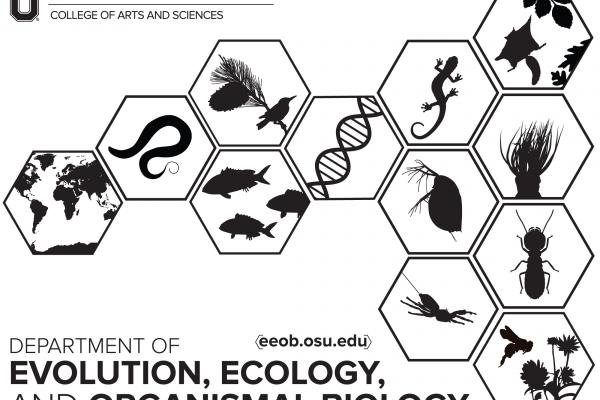November 22, 2017
Publications by EEOB faculty November 1 - November 30

Scientific Reasoning Abilities of In-Service Science Teachers in a Biology Modeling Workshop
Andria Stammen, Trudy Giasi, Courtney Irwin, Kristin Henkaline, Peter Lund, Karen Irving, Zakee Sabree, Kathy Malone. 2017. ResearchGate.
Abstract
The Modeling Biology Instruction: Leaders in Science and Engineering (MoBILiSE) Project is a collaboration between the 17 LEAs, and the Colleges of Education, Evolution, Ecology and Organismal Biology, and Engineering Education departments. Our presentation will describe the project and its effects on secondary teachers’ scientific reasoning skills.
Bayesian Inference of Selection in the Wright-Fisher Diffusion Model
Jeffrey J. Gory, Radu Herbei, Laura S. Kubatko. 2017. ArXiv.
Abstract
The increasing availability of population-level allele frequency data across one or more related populations necessitates the development of methods that can efficiently estimate population genetics parameters, such as the strength of selection acting on the population(s), from such data. Existing methods for this problem in the setting of the Wright-Fisher diffusion model are primarily likelihood-based, and rely on numerical approximation for likelihood computation and on bootstrapping for assessment of variability in the resulting estimates, requiring extensive computation. Recent work (Jenkins and Spano ́, 2015) has provided a method for obtaining exact samples from general Wright-Fisher diffusion processes, enabling the development of methods for Bayesian estimation in this setting. We develop and implement a Bayesian method for estimating the strength of selection based on the Wright-Fisher diffusion for data sampled at a single time point. The method utilizes the work of Jenkins and Spano ́ (2015) to develop a Markov chain Monte Carlo algorithm to draw samples from the joint posterior distribution of the selection coefficient and the allele frequencies. We demonstrate that when assumptions about the initial allele frequencies are accurate the method performs well for both simulated data and for an empirical data set on hypoxia in flies (Zhou et al., 2011), where we find evidence for strong positive selection in a region of chromosome 2L previously identified by Ronen et al. (2013). We discuss possible extensions of our method to the more general settings commonly encountered in practice, highlighting the advantages of Bayesian approaches to inference in this setting.
Biogeography of mutualistic fungi cultivated by leafcutter ants
Ulrich G. Mueller, Heather D. Ishak, Sofia M. Bruschi, Chad C. Smith, Jacob J. Herman, Scott E. Solomon, Alexander S. Mikheyev, Christian Rabeling, Jarrod J. Scott, Michael Cooper, Andre Rodrigues, Adriana Ortiz, Carlos R. F. Brandão, John E. Lattke, Fernando C. Pagnocca, Stephen A. Rehner, Ted R. Schultz, Heraldo L. Vasconcelos, Rachelle M. M. Adams, Martin Bollazzi, Rebecca M. Clark, Anna G. Himler, John S. LaPolla, Inara R. Leal, Robert A. Johnson, Flavio Roces, Jeffrey Sosa-Calvo, Rainer Wirth, Maurício Bacci Jr. 2017. DOI: 10.1111/mec.14431
Abstract
Leafcutter ants propagate co-evolving fungi for food. The nearly 50 species of leafcutter ants (Atta, Acromyrmex) range from Argentina to the United States, with the greatest species diversity in southern South America. We elucidate the biogeography of fungi cultivated by leafcutter ants using DNA sequence and microsatellite-marker analyses of 474 cultivars collected across the leafcutter range. Fungal cultivars belong to two clades (Clade-A and Clade-B). The dominant and widespread Clade-A cultivars form three genotype clusters, with their relative prevalence corresponding to southern South America, northern South America, Central and North America. Admixture between Clade-A populations supports genetic exchange within a single species, Leucocoprinus gongylophorus. Some leafcutter species that cut grass as fungicultural substrate are specialized to cultivate Clade-B fungi, whereas leafcutters preferring dicot plants appear specialized on Clade-A fungi. Cultivar sharing between sympatric leafcutter species occurs frequently such that cultivars of Atta are not distinct from those of Acromyrmex. Leafcutters specialized on Clade-B fungi occur only in South America. Diversity of Clade-A fungi is greatest in South America, but minimal in Central and North America. Maximum cultivar diversity in South America is predicted by the Kusnezov–Fowler hypothesis that leafcutter ants originated in subtropical South America and only dicot-specialized leafcutter ants migrated out of South America, but the cultivar diversity becomes also compatible with a recently proposed hypothesis of a Central American origin by postulating that leafcutter ants acquired novel cultivars many times from other nonleafcutter fungus-growing ants during their migrations from Central America across South America. We evaluate these biogeographic hypotheses in the light of estimated dates for the origins of leafcutter ants and their cultivars.
Thermoregulation: Bugs battle stress from hot blood
Joshua B Benoit, David L Denlinger. eLife 2017;6:e33035 DOI: 10.7554/eLife.33035.
